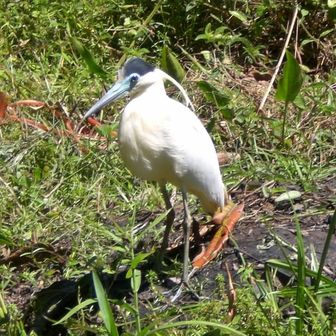Capped Heron

Original source: Ave_branca.JPG
Author: derivative work: Snowmanradio (talk)
Permission: GNU Free Documentation License
The Capped Heron is classified as Least Concern. Does not qualify for a more at risk category. Widespread and abundant taxa are included in this category.
The Capped Heron (Pilherodius pileatus) is a species of heron in the Ardeidae family. It is in the monotypic genus Pilherodius. It is found in Bolivia, Brazil, Colombia, Ecuador, French Guiana, Guyana, Panama, Paraguay, Peru, Suriname, and Venezuela. Its natural habitats are rivers, swamps, and freshwater lakes.It feeds on frogs,lizards,fish,insects,crabs,small mammals,and young birds. References - * BirdLife International (2008). Pilherodius pileatus. In: IUCN 2008. More
The nesting behaviour of the Capped Heron is poorly known. The nest is built relatively low in tree. It is typically made with sticks. Observations from captive birds in Miami (US) give a clutch of 2-4 eggs. Incubation lasts about 26-27 days. Chicks are covered in white down and fed by both parents. DIET: Capped Heron feeds mainly on very small fish, amphibians and aquatic insects and larvae, taken in shallow water or at water edge. More
Capped Heron Capped Heron From: grooveyard uploaded: 05/13/08 shot: views: 757 tags: South America, Peru, Tropical Forest, Birds, Rainforest, Jungle, Capped Heron, Wildlife, Boca Manu, Manu, Brief Description: Capped Heron in flight near Boca Manu, the junction of the Manu and Madre de Dios rivers. More
Bibliography used on the Capped Heron (Pilherodius pileatus) in the Birds in the Zoo. More
The Capped Heron (Pilherodius pileatus) in the Birds. More
The Capped Heron, Pilherodius pileatus, occurs south of central Panama to northern Bolivia, Paraguay and southeastern Brazil. This was one of my favorite wading birds on the trip. Its pastel coloring and black cap make it strikingly beautiful. BUY IT NOW Go to Purchase Information for explanation of options. More
Capped heronBirds in Suriname = - Capped heron, Pilherodius pileatus The Cocoi Heron above was photographed by Carl Beel at the Raleigh Falls nature reserve in Suriname in April 2010. The birds are shy and almost always alone, active by day and are mostly seen standing or very slowly moving along a riverbank in the interior, trying to catch fish. Capped herons are mainly white with a blue bill and a black cap. More

Original source: Caleb Slemmons
-Caleb Slemmons -Author: Caleb Slemmons
Permission: Some rights reserved
Family : Ardeidae
Genus : Pilherodius
Species : pileatus
Authority : (Boddaert, 1783)
